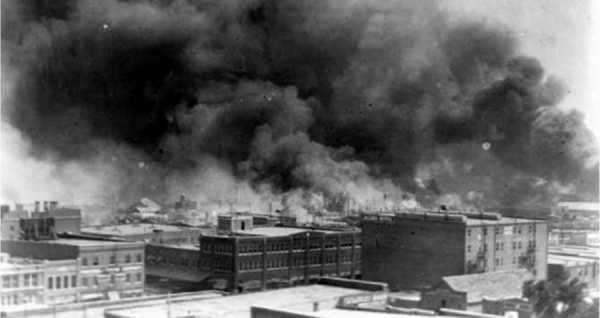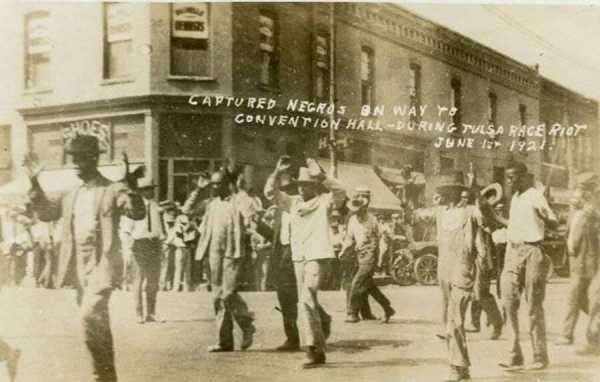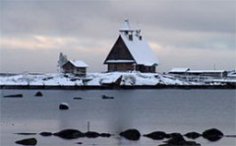Nearly 100 years after the Tulsa race riots that burned down ‘Black Wall Street,’ the city is coming closer to reckoning with its bloody past.

Library of Congress
Researchers believe they have found a mass grave filled with bodies belonging to victims of the Tulsa race riots.
Those demanding answers for the black victims killed in the 1921 Tulsa race riots are getting much closer to their wish, after the city announced the possible discovery of a mass grave site believed to be linked to the tragedy.
As reported by NBC News, researchers at the University of Oklahoma believe they have uncovered a possible mass grave site of the riot victims in the city’s Oaklawn Cemetery. The finding was announced by Scott Hammerstedt, a senior researcher for the Oklahoma Archeological Survey, during a public hearing of the city’s ongoing investigation into the massacre.
Through the use of geophysical scanning, experts were able to identify two unmarked spots at the Oaklawn Cemetery that appear to contain a number of corpses. Surveys performed by researchers confirmed their suspicions, indicating there were unaccounted human bodies buried 30 feet beneath the cemetery’s surface.
Unfortunately, researchers were unable to determine how many bodies are buried under the trenches. Still, they believe the unmarked graves could very well be linked to the massacre.
“I’m as confident as I can be in the results that this is a very big candidate with something associated with the massacre,” Hammerstedt said of the findings. For years, the city’s black residents had heard rumors that bodies from the bloody riot had been dumped into secret mass graves.
The rumors remained hearsay until October of last year when Tulsa Mayor G.T. Bynum announced via Facebook that he would be launching an official investigation into the matter.

Rev. Dr. Robert Turner/NBC NewsVernon A.M.E. Church is the only black church that survived the Tulsa riots.
“All Tulsans deserve to know what happened in 1921 — especially the descendants of victims,” Bynum wrote in his announcement. “This is a matter of basic human decency.” He added that the investigation would focus on three separate locations — the Oaklawn Cemetery, Newblock Park, and the Booker T. Washington Cemetery.
Those three sites indicated “the greatest potential for mass graves within the Tulsa city limits,” according to a 2001 report on the aftermath of the Tulsa race riots.
In addition to geophysical scanning, investigators used other advanced technological tools to identify the hidden graves, including ground-penetrating radar (GPR) and magnetic gradiometry.
The opening of the formal investigation to find the lost bodies of the Tulsa riot victims was a welcome surprise for city residents. But the investigation might have not come to fruition so soon if it weren’t for Rev. Dr. Robert Turner, who reminded the mayor about his campaign’s promise for a formal investigation during a public luncheon.
“This is blood land, this was a sacred space where people were burned alive,” said Rev. Dr. Robert Turner. “The Greenwood District is not just a tourist site, it’s a crime scene.”
The reverend leads the congregation at Vernon Chapel A.M.E. Church, the only surviving African American church from the 1921 riots. The church’s structure survived the riots, but many of its members were among the hundreds who perished in those two days.
In 1921, a mass riot erupted in Tulsa, Oklahoma, after a black 19-year-old shoe shiner was accused of sexually assaulting a white 17-year-old girl in an elevator. No one knows what really happened, but according to the 2001 report, the 19-year-old may have merely grabbed her arm after accidentally tripping and falling.

Tulsa Historical Society & Museum
Black men being marched down at gun point through the streets of Greenwood.
About 1,500 armed white men squared off against 75 black men outside the courthouse following the black man’s arrest. After a fight broke out, white rioters made their way into the city’s wealthy Greenwood district, known as Black Wall Street after the neighborhood’s thriving black-owned businesses.
The white mob, which included members of the Ku Klux Klan, looted and burned down the district’s shops and homes. An estimated 30 to 300 black people were killed while many others were displaced.
The Tulsa race riots are a blemish on the city’s history that was almost lost to time; many avoided speaking publicly about the tragedy due to the shame and anger attached to it.
“For decades it was hush-hush,” photojournalist Kavin Ross told CBS News. “Even some of the survivors that I interviewed, they were quiet and telling me, ‘Oh and the white people—’ They were whispering in their own homes because they were brought up not talking about what happened.”
But recently, conversations around the Tulsa race riots have opened up, so much so that the incident gained renewed attention after it was reenacted on the HBO series, Watchmen.
Now that some of the bodies of riots’ victims have been located, residents are just beginning to openly reckon with their town’s bloody past.
“I have to say it’s bittersweet,” said Greg Robinson, who is on the investigation’s public oversight committee. “To hear that the city has commissioned the research and that we have probably found mass graves belonging to race massacre victims.”
Forensic anthropologist Phoebe Stubblefield, who works at the University of Florida, cautioned that it’s unlikely researchers will be able to identify any remains found because of the unpredictable levels of preservation the bodies might have suffered.
But while the people of Tulsa won’t get all the answers right away, at least it’ll be a start.
Next, take a look at 24 harrowing photos of the 1967 Detroit Riots and learn how New York’s deadly Astor Place Riot was sparked by a performance of ‘Macbeth’.
Sourse: www.allthatsinteresting.com





